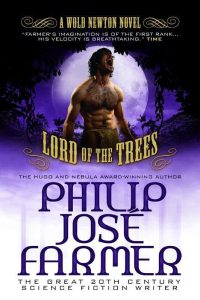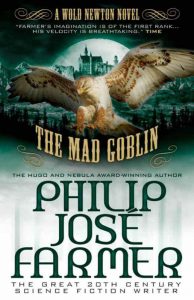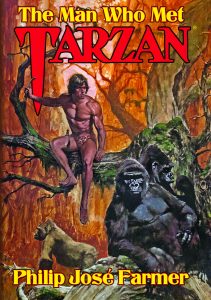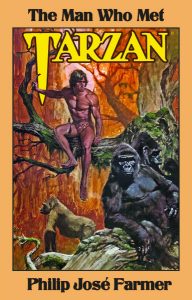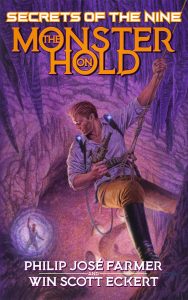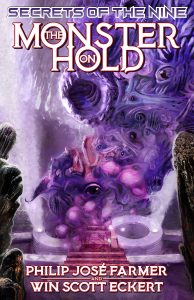Short story deadlines, anthologies and collection have rather consumed my time so far this year, but today we’re fortunate to have one of Dave Brzeski’s in-depth reviews covering, well, quite a lot. New Meteor House publications, and the strange worlds of Philip José Farmer, especially that of the Secrets of the Nine…
SECRETS OF THE NINE
by Dave Brzeski
It’s that time again, when I review the new books from Meteor House. This year, they’re pretty special.
Two out of the three are follow-ups to Philip José Farmer’s classic Secrets of the Nine series, which comprise: A Feast Unknown (1969), Lord of the Trees (1970) & The Mad Goblin (1970).
The series as a whole, and the new books, It’s Always Darkest, by Frank Schildiner, and The Monster on Hold, by Philip José Farmer & Win Scott Eckert, were discussed at length on the Secrets of the Nine panel at Farmercon XVI (2021). It’s well worth watching. It can be found on YouTube, here: https://www.youtube.com/watch?v=73cKxYR2PSI
FRANK SCHILDINER – IT’S ALWAYS DARKEST
I’m very familiar with Schildiner’s work, both in, and outside of Farmer’s Wold Newton Universe, so I had no doubt I’d find this short novel of interest.
The original three books by Farmer tell the story of how Lord Grandrith and Doc Caliban (unashamed pastiches of Tarzan and Doc Savage) turned against the mysterious Nine – a group of immortals who have manipulated World events in the background, since pre-history. I don’t really want to go into too much detail about that, as it’s all well-covered in that video. Do go watch it.
Whereas Grandith (pronounced Grunith), and Doc Caliban are fighting directly against the Nine, Schildiner’s Langston Dupont takes a more street level approach, in battling the various organisations which support them – be it knowingly, or otherwise.
Dupont is not so much a pastiche of any particular character. He’s more of a conglomerate of all the many dozens of Dark Avenger type heroes of the pulps, and comics, such as The Shadow, Batman etc. Dupont, however, does not operate under a codename, nor does he have a team of aides, in the way that the Shadow and Doc Savage do. He appears to work alone, for the most part, but his martial arts skills, and part-Asian heritage set him apart.
When it comes to battling The Nine themselves, Dupont quickly realises that he’s outclassed, so he goes to work chipping away at their organisation at the lower levels, taking out their agents as and when he can. As with all such pulp heroes, he has a nemesis, but this time it’s the woman he loves. Like Grandith & Caliban, Dupont also served the Nine for a very long time, before all three defected. Dupont’s criminal mastermind ex, Seiko Midori, sadly still follows her evil masters.
As I have come to expect from Schildiner, It’s Always Darkest is a fast-paced and very enjoyable pulp adventure. It is, it can’t be denied, rather violent, just as the Farmer series (especially A Feast Unknown) was. It’s also set in the 70s, and the author has intentionally styled it after the popular men’s adventure magazines, and paperback series of that period. Schildiner is, in fact, a mixed martial arts instructor by profession, so his fight scenes couldn’t be any more authentic. The man knows what he’s talking about!
If I really, really wanted to nitpick, it would be that I noticed some repetition in that Dupont comments on the woeful lack of taste of no less than three people, despite their advantages in looks/wealth and power. I can’t see that having passed the notice of the editors, so I’m going to assume it’s simply a character trait of Dupont’s – perhaps he’s a bit of a snob.
The book does work perfectly well as a stand-alone, but there is one seemingly minor scene, which might not mean much to those who don’t also read The Monster on Hold.
I do rather hope to read more of Dupont’s adventures in the future, whether, or not they involve The Nine.
The gorgeous cover and interior art are by Keith Howell!
Find it here: https://meteorhousepress.com/its-always-darkest/
NB: This is a limited (150 copies) signed hardcover only, so if you want it, you should order it quickly!
PHILIP JOSÉ FARMER – THE MAN WHO MET TARZAN
The second book I’m covering here is a bit different, in that The Man Who Met Tarzan is non-fiction. I’ll save myself some typing by cut & pasting directly from the press release…
“Most people familiar with Philip José Farmer know of his Tarzan Alive: A Definitive Biography of Lord Greystoke. In fact many became fans of Farmer because of this book. Less well known are the many other articles, essays, letters, and speeches Farmer wrote about Edgar Rice Burroughs and Tarzan over a span of several decades. This collection, The Man Who Met Tarzan, brings many of these together culminating in the high point of his actually interviewing Lord Greystoke himself!”
I’m not going to individually cover every separate piece presented here. That would take too long. Let me start, however, with a warning!…
If you’re one of those people who’ve never read Farmer’s Tarzan Alive: A Definitive Biography of Lord Greystoke, or Doc Savage: His Apocalyptic Life, you may not be aware of the danger. This book will suck you in! Of particular note are the two connected pieces, ‘Some Problems in Writing the Tarzan Biography’ and ‘The Great Korak Time Discrepancy’. If you didn’t previously consider yourself anal enough to care about discrepancies in the works of Edgar Rice Burroughs, then there’s a good chance this will change your mind. And once you then inevitably buy a copy of Tarzan Alive… believe me, the list of books, by a multitude of authors, about a multitude of characters, that you absolutely need to get and read will grow exponentially. I write as one who fell into this trap back in the mid-seventies.
It can’t be denied that this book is a geek’s paradise. But don’t be put off if you don’t consider yourself to be all that nerdy. It is, in fact, far more entertaining a read than the concept suggests. I admit that I found ‘From ERB to Ygg’, which traces Edgar Rice Burrough’s family tree all the way back to the Norse god Woden (aka Odin, or Ygg), a little dry, and ended up skimming it, but that was just 9 pages out of over 250.
By the time we got to the real meat of the book, in the second half, I found it hard to put down, especially the ‘Extracts From the Memoirs of Lord Greystoke’, which clarified so much of the more unlikely elements of ERB’s novels, and ‘An Exclusive Interview with Lord Greystoke’, in which you can cut the tension between Farmer and the jungle lord with a knife.
It’s fascinating to follow the trains of thought of Farmer and others as they argue over the discrepancies in the fictionalised accounts, and try to rationalise them with the real life man who was Tarzan.
I was intrigued to read between the lines of some of the material written by Win Scott Eckert, and others which almost suggested that they didn’t really believe Farmer’s stance on Tarzan having been based on a real, living person… but I put that down to a continued effort to protect the jungle lord’s privacy.
This book is available in a Trade Paperback as well as a Signed Hardcover Limited Edition (signed by Christopher Paul Carey, Win Scott Eckert, Henry Franke, Keith Howell, and John Solie)!
The hardcover features a leatherette cover with gold foil stamping, colored end papers and two interior color images. A fine quality collectible edition to be sure.
As with It’s Always Darkest, there’s an interesting panel discussion of the book on YouTube, here. https://www.youtube.com/watch?v=j9BBYl6N9vs I encourage you all to go watch it.
It can be ordered in paperback, and hardcover here: https://meteorhousepress.com/the-man-who-met-tarzan/
PHILIP JOSÉ FARMER & WIN SCOTT ECKERT – THE MONSTER ON HOLD
Which brings me to the main event. The Monster on Hold is an almost legendary planned, but unwritten, fourth novel in the Secrets of the Nine series, by Philip José Farmer. It fell to Win Scott Eckert to complete the work from Farmer’s outline and notes, and I doubt the task could have fallen to anyone better suited.
Eckert stresses in the panel video linked at the top of this article that you really don’t need to read all the earlier material… but it does help. It doesn’t really matter which order you read them in (apart from the Secrets of the Nine series, which should be read in order), much in the way it doesn’t matter which areas of a jigsaw you fill in first, but reading them all does eventually lead to a clearer, bigger picture.
For my part, I had read some of the relevant works fairly recently – Escape to Loki (Farmer’s novel of the earliest adventure of Doc Savage), and The Other Log of Phileas Fogg (in which we learn much about the Eridani and the Capellas), and some so long ago that I decided a reread was in order. So I read the original Doc Savage pulp story, Up From Earth’s Center (it’s fairly easy to find this in a reprint, or even a free download if you hunt around), A Feast Unknown, Lord of the Trees and The Mad Goblin again.
The Multiverse concept is pretty popular in the media these days. Both Marvel and DC have long used it to great effect in their comics, and this trend has increased dramatically in recent years. The idea has also now been embraced by the film and TV franchises based on their properties. The cynic in me does see this as a method by which they can justify the constant rebooting, and changing things from comic series to comic series, film to film, and TV series to TV series that we’ve – would ‘suffered’ be too strong a word? – over the last couple of decades.
Farmer and Eckert have put rather more thought into things. While it has been employed as a clever method to rationalise Farmer’s various Edgar Rice Burroughs pastiches, and tie in several of his other ideas, in this case it very much serves the tale they wanted to tell… and it works so well. I think one of Eckert’s best contributions is in the subtle ways he highlights the differences between Doc Caliban, and Doc Savage (or I should probably refer to him as Doc Wildman – his real name).
The first part of this novel – Some Unspeakable Dweller (1977) – follows Doc Caliban in his continued fight against his former masters, The Nine. His position is now quite tenuous, as he is in constant threat of assassination if the agents of The Nine can track him down. Caliban and his companions beard one of the five remaining Nine in his den, and soon find themselves fighting for their lives. They also suffer some quite severe hallucinatory experiences.
In Part II – The Guardian at the Threshold (1984), Doc Caliban captures an agent of The Nine, who turns out to be his universe’s version of a character from that pulp adventure (he apparently having shared a similar story to that of Doc Wildman in the late 1940s). Now he began to understand the truth behind that first adventure. In the eighteenth century, The Nine had summoned an entity from an alternate dimension to help them quell a previous insurrection. Once done, they found they couldn’t banish it back from whence it came, so they now kept it in abeyance in a deep cave in New England, in a place which was in neither of Caliban and Wildman’s universes, but a bridge to both. Caliban is told that what remains of The Nine plan on making further use of this entity… until they finally put an end to Caliban, Grandrith and their friends. He also learns that it’s the source of the hallucinogenic visions that he, and his companions have been suffering from ever since the events of the first part. He doesn’t know what to believe for sure, but he knows he has to go back into that cave.
I was quite surprised at how strong the ties to the Doc Savage pulp, Up From Earth’s Center, were to The Monster on Hold. This seems to be in some ways an attempt by Farmer to rationalise what was really one of the weakest (and the last to be published in the pulp magazine) of the Doc Savage stories, which has been up to now pretty much dismissed as an imaginary tale, in that it just didn’t really work within the Doc Savage universe. The idea of the very rational science hero, Doc Savage, discovering that Hell really existed in the bowels of the Earth, and was accessible via some caves in New England was just a bit too silly. Farmer makes it work, though, and in the process, ties it all in to H.P. Lovecraft’s Chtulhu Mythos.
The third part – Down to Earth’s Centre (1984) – takes us with Caliban as he ventures back down into the caves which had so terrified him back in 1948 (I couldn’t help but wonder if the two dates were a nod to the original title, and publishing date, of Orwell’s 1984). Both hindered and helped by visions, in which he seems to be able to see through the eyes of the other, while that other can see through his eyes, he faces the most frightening experience of his long life.
It’s an exciting page-turner of an adventure to be sure, and great fun for all the Farmer fans who love to work out all the connections, but it’s so much more than that. The Monster on Hold, indeed the entire series, is also a fascinating look at the effect their extreme upbringing had on the psyches of young Grandith, and Caliban. They are immensely powerful, and intelligent heroes to be sure, but they are also so very damaged by their extremely unusual upbringings. This sort of thing has been attempted before with other heroes, most notably Batman, but never have I seen it done so well as Farmer (and Eckert) have done here. It’s quite an achievement. The moral implications of the methodology Doc Savage employed, in the earlier Doc Savage pulp adventures, to cure his enemies criminal tendencies is also brought into question.
The Monster On Hold does not end there, however. There’s a plethora of bonus material in the book, staring with a reprint of Win Scott Eckert’s ‘The Wild Huntsman’, originally published in The Worlds of Philip José Farmer, Volume 3: Portraits of a Trickster (Meteor House 2012). I’d read it in that original appearance, and while I did enjoy it, I have to say it worked so much better, re-reading it after reading all four of the Secrets of the Nine series, of which it’s an important part. Here, we discover how the Xaoxaz of one Earth discovered the existence of his counterpart on another, what he did next and how that ties in to the struggle between the Eridani and the Capellas on one Earth and the fall to Earth of a certain meteorite on another, bringing in the events of Time’s Last Gift, and so many other works along the way. Re-reading this story at this point took it from being a good Wold Newton tale to an essential, and excellent piece of a larger puzzle. It really needed to be included in this book.
The rest of the book is devoted to the various sources Eckert used to complete The Monster on Hold, from Farmer’s notes etc., which were found in what has become known as his ‘Magic Filing Cabinet’. First we get material scanned from Farmer’s handwritten notes, and typescripts. The handwritten notes are very interesting to see, but frankly, Farmer’s handwriting is almost as bad as mine, which makes it quite difficult to read. The typescripts are easier, of course, but they were presented as scans of the original pages, which means the text size is reduced considerably from the original letter-sized (8.5”x11”) pages. Of particular interest is a letter from Farmer to the Scott Meredith Literary Agency, discussing his plans for writing Escape From Loki, his canonical Doc Savage novel. It’s fascinating to see how his thoughts on The Monster on Hold were gradually taking shape, and how they changed over time.
‘Philip Jose Farmer’s Original Prose and Outline’ is pretty much what it says on the tin. First we get three chapters that Farmer wrote sometime in the 1970s – ‘Up From the Earth’s Centre’ (an earlier title for The Monster on Hold, used here to avoid confusion). Here we follow a character using the codename ‘Lacewing’ (a golden-eyed insect), as he takes a familiar trip into the bowels of the Earth. Given the similarities, and differences with the final novel – in fact Doc Wildman also uses that codename in one of Caliban’s visions – one could assume this took place in yet another alternate universe.
Following this, we get the remainder of Farmer’s comments from the 1983 World Fantasy Convention program, outlining the novel, followed by his original version of a first chapter.
At this point, dear reader, you may be forgiven for thinking that this is all much too complicated to deal with. But fear not; in ‘A Tale of Two Universes’, and ‘A Feast Revealed: A Chronology of Major Events Pertinent to the Secrets of the Nine Series’, Eckert goes to a lot of effort to clarify it all for us. Finally, in ‘A Note from the Coauthor’, he acknowledges his many sources, and lists all the pertinent books that we may want to read… and, yes, this does include a few I have yet to get to myself!
Featuring an introduction by Bronze Gazette editor Chuck Welch, The Monster on Hold is available in a Trade Paperback (featuring cover art by Doug Klauba – included in the hardcover as a full-colour frontispiece) and a Signed Hardcover Limited Edition (featuring a wraparound jacket by Mark Wheatley). Each edition also includes interior artwork by both artists. The hardcover is signed by Win Scott Eckert, Chuck Welch, Doug Klauba, and Mark Wheatley!
Find it here: https://meteorhousepress.com/the-monster-on-hold/
At the time of writing, all of the limited, signed hardcovers are almost sold out.
Whilst you’re pondering the above, why not have a look at John Linwood Grant’s own recent second collection,Where All is Night, and Starless (Trepidatio 2021). It’s not bad.
AVAILABLE NOW THROUGH AMAZON UK & US, AND THROUGH THE PUBLISHER, JOURNALSTONE
Amazon US: Where All is Night, and Starless
Amazon UK: Where All is Night, and Starless

